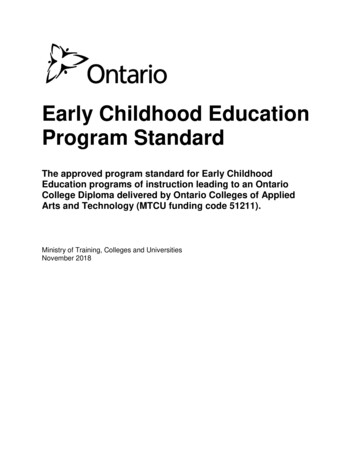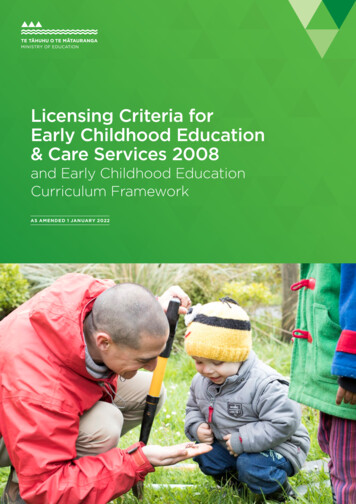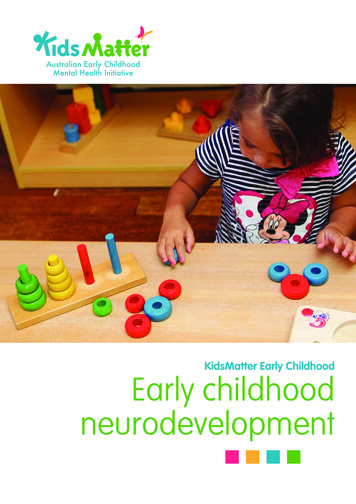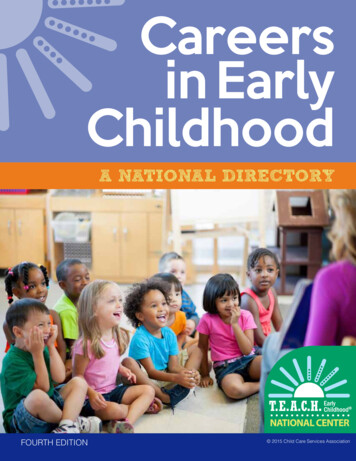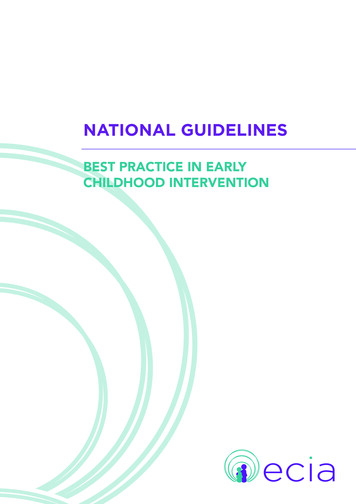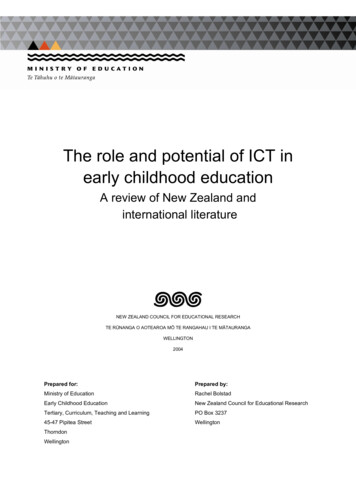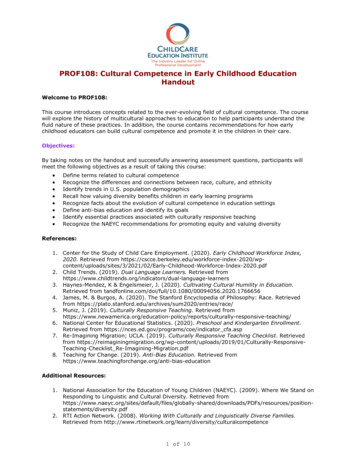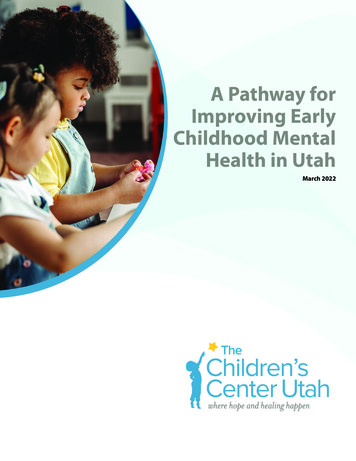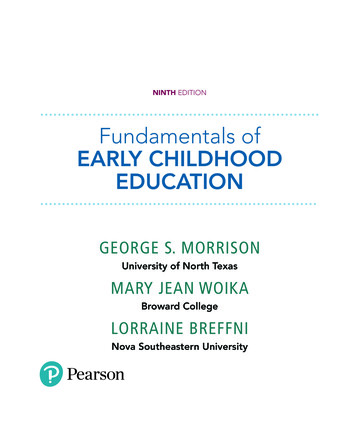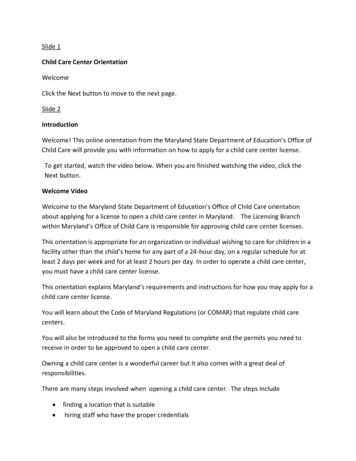
Transcription
Slide 1Child Care Center OrientationWelcomeClick the Next button to move to the next page.Slide 2IntroductionWelcome! This online orientation from the Maryland State Department of Education’s Office ofChild Care will provide you with information on how to apply for a child care center license.To get started, watch the video below. When you are finished watching the video, click theNext button.Welcome VideoWelcome to the Maryland State Department of Education’s Office of Child Care orientationabout applying for a license to open a child care center in Maryland. The Licensing Branchwithin Maryland’s Office of Child Care is responsible for approving child care center licenses.This orientation is appropriate for an organization or individual wishing to care for children in afacility other than the child’s home for any part of a 24-hour day, on a regular schedule for atleast 2 days per week and for at least 2 hours per day. In order to operate a child care center,you must have a child care center license.This orientation explains Maryland’s requirements and instructions for how you may apply for achild care center license.You will learn about the Code of Maryland Regulations (or COMAR) that regulate child carecenters.You will also be introduced to the forms you need to complete and the permits you need toreceive in order to be approved to open a child care center.Owning a child care center is a wonderful career but it also comes with a great deal ofresponsibilities.There are many steps involved when opening a child care center. The steps include finding a location that is suitablehiring staff who have the proper credentials
making an emergency planplanning meals and activitiesand submitting all your required documentation.Applications for child care center licenses are processed by the Licensing Branch’s RegionalOffice that regulates child care in the county where you desire to provide services.If you decide you do wish to apply for a license, completion of this orientation is mandatory.Once you finish it, the Office of Child Care will be notified. You must click on and review everyslide in order to successfully complete this orientation.Now a quick word about how to navigate through the presentation. It will take about one hourto review all slides and complete the Check Your Understanding activities.You can complete a portion of the orientation and return later to pick up where you left off.Click the Next and Previous buttons to move ahead or go back.You can also use the Menu links on the left to move from slide to slide.Click the orange audio button to hear the slides narrated, and click blue links to go to forms andresources.There is also a link to all Forms & Resources in the upper right of the orientation.On slides with a video, click the pointer to play and pause the video, and the CC button to readclosed caption narration.Please bookmark this presentation so you can return frequently.Now, let’s get started!Slide 3Resources and SupportMaryland has 13 regional Offices of Child Care across the state. As you go through thisorientation, you will see many steps that suggest you check with your regional office.After you turn in your Notice of Intent, licensing staff will be assigned to work with you as youmove through the process.The licensing staff will:
Answer questions about the documents you are required to submit when applying for alicense.Direct you to find training resources.Provide guidance before and after you start your center.Take a moment now to visit the Regional Licensing Offices page and find the phone numberand web page for your regional office.Another resource to explore is the Maryland Child Care Resource Network. Their regionaloffices direct you to find training and help explain licensing requirements.Click the Next button to move to the next page.Slide 4COMAR RegulationsAll regulations and requirements for operating a child care center in Maryland are listed in theCode of Maryland Regulations (COMAR) 13A.16.Before you start the licensing application process, download COMAR 13A.16. You must readand understand this document in order to operate a child care center. Then, watch the videobelow to get a brief overview of COMAR 13A.16.When you are finished watching the video, click the Next button.COMAR Overview VideoIn the introduction video to this orientation, you learned that the Code of Maryland Regulations(or COMAR) regulates child care centers.Many topics are covered under COMAR, but the one that deals with child care centers isCOMAR 13A.16.The goal of COMAR 13A.16 is to create safe and nurturing child care environments for childrenin Maryland.You will need to fully understand these regulations to be successful in applying for a child carelicense.To get familiar with them, let’s take a brief look at COMAR 13A.16.The document covers 49 pages, so there is a lot to read.
There is a table of contents, and then 19 sections, which group the regulations into topics.COMAR 13A.16 provides requirements on everything from a center’s physical space, toprogram requirements, to the nutritional value of the meals served at the center.The regulations also outline safety procedures that child care centers must follow, as well asthe rules that govern a center’s staffing and hiring.On the next few pages of this orientation, you will learn more about some of these regulations.Please bookmark COMAR 13A.16 on your computer so you can refer to it now and in the future.Slide 5Check Your UnderstandingReading COMAR 13A.16 can be overwhelming. However, as a child care center owner, you mustknow all of these regulations. Let’s see if you know where to get help.Check all of the boxes that show organizations that can offer you help as you apply for yourchild care license in Maryland. Make your selection and click Submit.The choices are:Maryland Child Care Resource NetworkRegional Offices of Child CareMaryland Department of Natural ResourcesAnswer:The correct answers are:Regional Offices of Child Care andMaryland Child Care Resource NetworkSlide 6COMAR Close-Up: Space & EquipmentNow take a closer look at some of the COMAR requirements.
Watch this video to review areas covered under COMAR 13A.16.05 Physical Plant & Equipment.Remember, the video offers highlighted information but you must read COMAR to understandall of the regulations.When you are finished watching the video, click the Next button.Physical Plant and Equipment Overview VideoA safe and inviting space is essential to a successful child care center.In COMAR 13A.16.05, Physical Plant and Equipment, there are many regulations for indoor andoutdoor space.Let’s review some of these regulations by touring a child care center. Remember, thisinformation in COMAR is very detailed and specific.When it comes to indoor space, Maryland law requires that child care centers provide at least35 square feet of usable space per child, so a center with ten children enrolled would need 350square feet of usable interior space. There are a few exceptions to this rule, so carefully reviewthe requirement if you do not have this amount of space.And - this is important - bathrooms, hallways, and space used exclusively by teachers - such asstorage closets or staff rooms - do not count for the 35 square feet per child allotment.When selecting a space for your center, be sure to first have a good sense of your desiredenrollment, and measure your space carefully.You will also need to be very aware of lead paint. It poses a serious health risk to everyone, butparticularly to young children. Maryland law requires child care centers to operate in lead-safeenvironments. If you want to use a residential rental property built before 1978 for your childcare center, you must submit a copy of the current lead-risk reduction or lead-free certificate. Ifthe building was constructed prior to 1978 and is not certified as lead-free, you must ensurethere is no chipping or peeling of paint. If there is, you must arrange to get a lead dust test. Aninspector must verify that the building can be used.Maryland regulations also require a child care center to provide: at least one drinking water source, reachable by children 2 and older, for every 40childrena diapering area for infants and toddlers that has its own hand-washing sinkone toilet and sink for every 15 children who are 2 years and oldera telephone that remains on the premises and
a clean environment that is free of infestation.Now that we have covered some important regulations inside, let’s step outdoors to see whatthe requirements are. Each center is required to have an outdoor play area, either on itspremises, or safely accessible to the center.If a center has 20 or fewer children enrolled, the outdoor area must provide at least 75 squarefeet per child.If a center has 21 children or more, the outdoor space must provide 75 square feet for one-halfof the center’s approved capacity.This allows you to take half of the children outside at a time.So, a center with 10 children enrolled would need an outdoor space of 750 square feet, while acenter with 30 children would need 1125 square feet.For more details about the regulations listed in this video – and further regulations stipulatedby Maryland law -- please refer to COMAR 13A.16.05.Slide 7Check Your UnderstandingNow that you are a bit more familiar with regulations about physical space, take a few minutesto explore this interactive image of an indoor space. There are several areas that could beimproved for children.Can you find areas to improve? Click on the orange buttons for suggestions.Let’s begin with the Nap Area, so click the orange button on the window.Nap Area: Placing beds by the window is not a great idea since the sunshine may keep childrenfrom napping. In addition, all window shades must be cordless. Consider locating the nap areafarther from the windows.Now click the orange button above the Arts and Crafts Table.Arts & Crafts Table: Clean-up will be more difficult if the arts and craft area is not close to thesink. In addition, placing the table on a rug, not the floor, may make clean-up harder. If thetable is on the floor, it will be easier to sweep away loose paper under it. Consider moving thetable closer to the sink.Let’s go to the food area next, so click the orange button next to the fruit bowl.
Food Area: The area for eating is surrounded by toys. This could be a problem since childrenmay be distracted by the toys during snack time. A better solution would be to put the eatingarea off to the side and closer to the sink.Finally, let’s visit the diaper area so click the orange button above the changing table.Diaper Area: If the diaper table is set against the wall, a caregiver must have her back to otherchildren while she changes a baby. Instead, place the diaper area so that a caregiver can watchall children while she changes a diaper.Click the Next button to move to the next page.Slide 8COMAR Close-Up: Staff & ChildrenCOMAR contains very specific guidelines about qualifications for a child care director and staff.The regulations also include information about how many staff must be present, based on theage and number of children in care.Watch this video to review areas covered under COMAR 13A.16.06 Staff Requirements andCOMAR 13A.16.08 Child Supervision. Remember, the video offers highlighted information butyou must read COMAR to understand all of the regulations.When you are finished watching the video, click the Next button.Overview of Staff Requirements and Child Supervision VideoQualified, responsible staff members are an important part of a successful child care center.COMAR 13A.16.06, Staff Requirements, and COMAR 13A.16.08, Child Supervision, list therequirements and clearances required of each child care staff member. Many forms must besubmitted to the licensing staff within your regional Office of Child Care to verify that staff meetCOMAR requirements.These forms include: A criminal background clearance (this is called the Criminal Justice Information Systemsform);A release of information form, which gives permission to check the person’s child andadult abuse and neglect history with the Department of Social Services;
And a medical report on the person’s health.In addition to these basic clearances, COMAR lists specific requirements for different jobswithin a child care center. These jobs include the director, teachers, assistant teachers, aides,substitute teachers and volunteers.The requirements for each position vary depending on the size of the child care center and theages of the children served. There may also be a minimum age for the staff member, as well asspecific education, experience and ongoing training requirements.Center directors must pay careful attention to the number of staff members hired. COMAR hasspecific rules regarding the staff-to-child ratios that must be maintained for each group ofchildren. For instance, children who are between 6 weeks and 18 months require a 1:3 staff-tochild ratio – meaning for every 3 children in this age range, there must be 1 adult. Toddlers whoare 19 months to 23 months require a One to Three ratio, with a maximum group size of 9.Same age groups of 2-year-old children require a 1:6 ratio, with a maximum group size of 12; 3and 4-year-old children require a 1:10 ratio, with a maximum group size of 20; and children 5years and older require a 1:15 ratio, with a maximum group size of 30. Mixed-age groups havedifferent requirements so be sure to carefully read COMAR 13A.16.08.03 Group Size andStaffing.Remember to consult with COMAR when hiring staff members to make sure that your hiringpractices are in line with Maryland law.Child care support personnel, such as cooks, housekeepers and secretaries, are not required tosubmit high school or college information during the hiring process. However, these staffmembers must complete the criminal background clearance, release of information form, and amedical report.For more details about the staffing regulations listed in this video – and further regulationsstipulated by Maryland law -- please refer to COMAR 13A.16.06 and 13A.16.08.Slide 9Check Your UnderstandingReview resume highlights of four people applying for child care staff positions below. Next,decide which two candidates seem best qualified and would be candidates you would want tointerview. Click on the pictures of the two best candidates and then click Submit.Candidate 1:
Teacher at Baltimore’s Best Child Care CenterFirst aid trainingAssociate degree, Early Childhood EducationCandidate 2 Volunteer at Catoctin Child Care CenterHigh school diplomaSigned up for first aid trainingCandidate 3 Pursuing degree in special education Worked for Teach for America, elementary teacher Bilingual in English and SpanishCandidate 4 Substitute teacher at Chesapeake Child Care Center First aid training Bachelor’s degree in early childhood educationAnswer:The best candidates to interview are candidates 1 and 4. Candidate 1 – She has work experience, first aid training and the education background thatfit a center staff position. Candidate 4 – She also has work experience, first aid training and the education backgroundthat best fit the position.Slide 10COMAR Close-Up: Program RequirementsCOMAR 13A.16.09 Program Requirements reviews daily activities, furnishings and equipmentyou need to provide for children in your care.Watch the video below to review these areas. Remember, the video offers highlightedinformation but you must read COMAR to understand all of the requirements.When you are finished watching the video, click the Next button.
Program Requirements Overview VideoDaily activities for child care centers, which are called Program Requirements, are listed inCOMAR 13A.16.09. Maryland law requires that child care centers plan daily activities thatpromote the emotional, social, intellectual and physical growth of each child.Program activities should vary throughout the day, and include:o Vigorous play;o Creative and dramatic play;o Socialization;o Manipulation (including using construction materials);o Exploration of art, music, language arts, and science;o And individual pursuitsActivity plans should accommodate children of different ages and developmental levels. Inaddition, the toys, equipment and activity materials available within a center should be ageappropriate. This means a center must provide strollers or carriages for non-walkers and ageappropriate tables and chairs for toddlers. (Please note, centers are forbidden from using highchairs that do not have safety straps.)Sleep is another important part of child development, and it is also an important part of asuccessful child care center. COMAR requires that centers have appropriate nappingequipment. Children between the ages of 6 weeks and 12 months should nap in a crib that isapproved by the Consumer Product Safety Commission; children between the ages of 12 and 24months should sleep on a cot or mat, unless the parent has requested a crib; and children ages2-5 should have cots or mats.Another important aspect of daily care is “screen time” – this is the time children spendwatching television or using tablets and smart phones. Screen time may be interactive orpassive. There are requirements for the type of screen time and how long the technology maybe used.Interactive technology means educational and age-appropriate technology.Limited use of appropriate interactive technology may support, but does not replace, otherforms of learning, such as outdoor play, creative play, hands-on exploration, social interactions,etc.
Passive technology means non-interactive television, videos and streaming media. Viewingrestrictions for passive technology are: children under the age of 2 must not engage in any passive technologychildren older than 2 are not permitted to view more than 30 minutes of ageappropriate, educational passive technology per week.COMAR lists a few exceptions so review the regulation closely.For more details about the program requirements outlined in this video – and furtherregulations stipulated by Maryland law -- please refer to COMAR 13A.16.09.Slide 11Check Your UnderstandingNow check your understanding about daily activities.It is a rainy and cold day so you do not want to take the children in your care (ages 3-5) outside.Which of the following options is not an approved activity? Make your selection and clickSubmit.The choices are:Read the children a story and help them role-play scenes from the story.Help the children construct a miniature town using building blocks.Give the children large markers and paper, and ask them to draw the weather.Turn on a 2-hour educational movie so the children can relax and stay warm.Answer: The correct answer is that a maximum of 30 minutes per week of passive screen timeviewing is acceptable, but 2 hours of passive viewing is completely unacceptable.Slide 12COMAR Close-Up: SafetyThe safety of the children in your care is one of your greatest responsibilities.Watch this video to review areas covered under COMAR 13A.16.10 Safety. Remember, thevideo offers highlighted information but you must read COMAR to understand all of theregulations.
When you are finished watching the video, click the Next button.Safety Overview VideoCOMAR 13A.16.10, Safety, covers Maryland requirements for safety in a child care center.These regulations include compliance with local fire codes, and a written emergency anddisaster plan.Your emergency and disaster plan should establish procedures for the following: Evacuating the centerSheltering in place if evacuation is not possibleContacting parents, andAddressing the individual needs of children in the center, including those with specialneeds.The plan should also include contact numbers for staff members and emergency responseteams.Remember, an emergency and disaster plan is only as good as the people who carry it out. Tothis end, both the center staff and the children in your care must be familiar with the plan.When hired, all employees of the center should receive orientation regarding the emergencyand disaster plan.Center staff should practice the fire evacuation plan with children once per month, and practiceother emergency and disaster situations with the children twice per year.Maryland law also requires that child care centers have on the premises, at all times, at leastone staff member who is certified in basic first aid and cardiopulmonary resuscitation (CPR). Ifyour center has an approved capacity of more than 20 children, you must have at least onestaff person who is trained in first aid and CPR for every 20 children on site.A child care center must also maintain a first-aid kit that is easily accessible to staff members.Finally, hazardous materials and cleaning solutions must be kept out of children’s reach.For more details about the safety regulations listed in this video – and for further regulationsstipulated by Maryland law -- please refer to COMAR 13A.16.10.
Slide 13Check Your UnderstandingThe staff member trained in CPR is sick for the day. You have her cell phone number in casethere is a medical emergency. This is sufficient to get through one day.True or False? Make your selection and click Submit.Answer:The correct answer is False. At all times, including during an off-site activity, at least one familychild care teacher must be present who has successfully completed basic first aid training.Slide 14Check Your Understanding (Continued)Once a month, a fire evacuation drill must be practiced, and once a year, the writtenemergency and disaster plan must be updated.True or False? Make your selection and click Submit.Answer:The answer is true. Once a month, a fire evacuation drill must be practiced, and once a year,the written emergency and disaster plan mustbe updated.Slide 15COMAR Close-Up: NutritionIn COMAR 13A.16, food preparation, food storage and infant feeding are covered under thesection on Nutrition.Watch this video to review areas covered under COMAR 13A.16.12 Child Nutrition. Remember,the video offers highlighted information but you must read COMAR to understand all of theregulations.When you are finished watching the video, click the Next button.(Learn more about the USDA Child and Adult Care Food Program described in the video.)Nutrition Overview Video
Nutrition plays a vital role in a child’s physical and mental development. It is also an importantpart of a successful child care center. COMAR 13A.16.12 stipulates that child care centers servea certain number of snacks or meals each day, depending on the center’s hours of operation.The snacks and meals may be provided by the child’s family or by the center.If you plan to prepare meals and snacks in your child care center, you will need to submit a 4week sample menu to the licensing staff within your regional Office of Child Care. The mealsand/or snacks in your plan should follow the USDA Child and Adult Care Food ProgramGuidelines. You will also need the following within your center: A weekly menu, which must be posted on-site and visible to parentsA place for washing hands. There must be a hand-washing sink in the food prep area.A place for food storage. All perishable items, either provided by the center or theparents, must be refrigerated. Non-perishable items should be stored at least 6 inchesoff the floor, free from infestation and not placed beneath cleaning products.Finally, a center needs kitchen equipment and supplies that are clean and in goodcondition.Maryland law also requires that child care centers provide all beverages and milk with all meals.For children 2 years and older, you are required to serve 1% or nonfat milk, unless otherwiseordered by a health care provider or requested by the parent. Any other beverages served maynot contain added sweetener or caffeine, except infant formula or other beverages prescribedby a health-care provider. This does not apply to parents who provide lunch for their child.Also, be sure to check with your regional Office of Child Care to see if your center qualifies forthe Child and Adult Care Food Program. Eligible centers receive cash reimbursements tosupplement the cost of nutritious meals.For more details about the nutritional regulations listed in this video – and further regulationsstipulated by Maryland law -- please refer to COMAR 13A.16.12.Slide 16Check Your UnderstandingYou are planning the nutritional requirements for your child care center.Check all of the boxes that apply. Make your selection and click Submit.The choices are:
Post a weekly menu that is visible to parents.Serve whole milk to children 2 and older.Provide a place to wash hands in the food-prep area.Make sure food is stored properly and safely.Keep kitchen equipment and supplies clean and in good condition.Answer:The correct answers are: post a weekly menu; provide a place to wash hands in the food-preparea; make sure food is properly stored; and keep kitchen equipment and supplies clean.Slide 17Review FrequentlyYou have just completed an initial review of COMAR 13A.16. Good job! It is not easy to readand understand all of the requirements.Go back and review COMAR 13A.16 frequently during this orientation and in the comingmonths. You must know these regulations very well to run a child care center.Now it is time to move ahead and learn the steps needed to apply for a child care license.Click the Next button to move to the next page.Slide 18Applying for a Child Care Center LicenseThe time to obtain a license varies for each person. You should allow at least six months, onceyou have submitted your licensing application.The timeline on the right shows the big steps in obtaining your license. The following pages inthe orientation will review these steps in greater detail.Step 1: Notice of IntentStep 2: License ApplicationStep 3: PermitsStep 4: Additional Documents
Click the Next button to move to the next page.Slide 19Step 1: Notice of IntentThe first step in applying for a child care center license is to fill out and submit a Notice of Intentform to your regional Office of Child Care. This document informs the licensing staff that youplan to submit a licensing application.When you submit a Notice of Intent, you must also submit: A site plan. A site plan is a drawing that shows the area around your child care center. Itincludes your building and the streets around it. The drawing can be done by hand or ona computer.A floor plan. A floor plan is a drawing that shows what is inside your child care center. Itincludes rooms, hallways, exits and arrows that show how everyone gets out in case ofan emergency. Like the site plan, the floor plan can be drawn by hand or by using acomputer.Watch the video on the next slide for an overview of what is required in the Notice of Intentform.Click the Next button to move to the next page.Slide 20Step 1: Notice of Intent (Continued)The video below explains how to fill out the Notice of Intent.When you have your documents finished, you may email them to the licensing staff at yourregional Office of Child Care or deliver the documents in person. To find out the location andemail of your regional office, visit MSDE’s Regional Licensing Offices page.When you are finished watching the video, click the Next button.Notice of Intent VideoStep 1 in the process to apply for a child care center license is to fill out and submit a formcalled a Notice of Intent.You must fully complete the 2-page Notice of Intent form. In the first section, be sure to includethe facility name and proposed opening date, as well as all other fields.
In the Proposed Building, Scope of Service and Food Service sections, answer every question. Ifyou do not know the answer, ask your regional Office of Child Care how you can find out theinformation.The Notice of Intent form must be accompanied by a site plan and a floor plan of the facility,both of which must be drawn to scale.Your site plan is an “aerial view” of your center. It must show the location of the playground,parking areas, roads and adjacent buildings in relation to the facility.Your floor plan must show the general layout of the interior of your child care center. The planmust indicate if any changes are being made to the facility, such as the addition of toilets, sinks,drinking fountains, walls, etc. If the room is a large open space, then the plan must indicate howthe space will be used if more than one group of children will be accommodated.The purpose of submitting these plans prior to construction is to allow time for the licensingstaff to review the plans and provide consultation and recommendations. It is far simpler andless expensive to make changes to a plan on paper rather than having to make changes after astructure is built.Once you have completed the Notice of Intent and the accompanying documents, you shouldmail the documents to your regional Office of Child Care, or drop the form off in person.Slide 21Step 2: Licensing ApplicationOnce your regional Office of Child Care has received your Notice of Intent, you are ready towork on your Child Care Facility Application for License. Watch the video below for a step-bystep explanation of what is required in the application. Download the Child Care Facility Application for License form before watching the videoso you can follow along.Jot down questions you have and contact your regional Office of Child Care or the localMaryland Child Care Resource Network.When you are finished watching the video, click the Next button.Reviewing Your Application Document VideoWhen you fill out a Child Care Facility Application for License, be sure you carefully fill in all theinformation requested.
Let’s take a quick look at the application document OCC 1200.On page 1, in the Organizational Structure section, make sure you check the appropriate boxand fill out additional information if needed.Fill out all fields for
Child Care Center Orientation . Welcome . Click the Next button to move to the next page. Slide 2 . Introduction . Welcome! This online orientation from the Maryland State Department of Education's Office of Child Care will provide you with information on how to apply for a child care center license. To get started, watch the video below.
